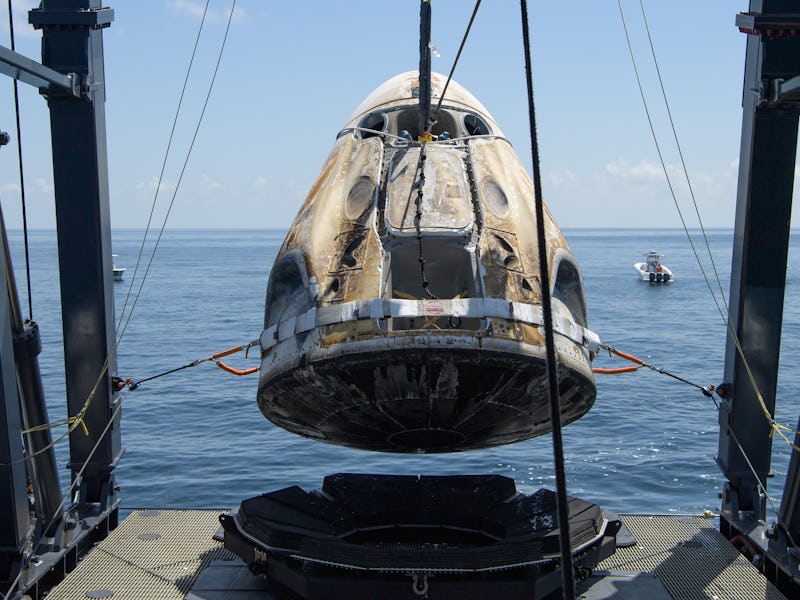SpaceX Crew Dragon: stunning photos show capsule's historic landing
SpaceX's human-carrying capsule, the Crew Dragon, has successfully returned to Earth.

The Crew Dragon, SpaceX's first capsule designed to send humans into space, has splashed down after its first crewed launch, dubbed Demo-2.
NASA astronauts Bob Behnken and Doug Hurley returned to Earth at 2:48 p.m. Eastern on Sunday, as the capsule hit the ocean just off the coast of Pensacola, Florida. According to NASA, this makes them the first crew to splash down since 1975.
About Demo-2 — The pair first took off in the capsule with the aid of a SpaceX Falcon 9 rocket on May 30 from the Kennedy Space Center in Florida, arriving at the International Space Station the following day.
Behnken and Hurley spent 63 days at the space station in total and completed over 110 hours of work. The mission also provided key data about SpaceX's new capsule.
Bob Behnken and Doug Hurley returning to Earth.
“This was an extraordinary mission, an extraordinary day for NASA, for SpaceX, and frankly, for Americans and anyone interested in spaceflight," Gwynne Shotwell, president of SpaceX, said in a statement shared by the agency.
A diagram of Crew Dragon's return to Earth.
Elon Musk highlighted the company's broader goals in comments after the splashdown. Writing on his Twitter page, the SpaceX CEO declared that "when space travel becomes as common as air travel, the future of civilization will be assured."
The Crew Dragon capsule returning to Earth.
The mission marks a new era for commercial spaceflight. After NASA ended the space shuttle program in 2011, the agency has been using Soyuz rockets from Russian agency Roscosmos to send its astronauts to space, taking off from the Baikonur Cosmodrome in Kazakhstan. SpaceX's successful launch means those astronauts will be able to take off from the United States once again, while also marking a new form of collaboration between the private and public sector.
The Crew Dragon capsule returning to Earth.
The splashdown demonstrated three things. It showed the Crew Dragon is capable of returning humans to Earth safely. It also showed the capsule could bring back cargo from space as needed. Thanks to the successful efforts of the teams on the ground, the splashdown also showed that teams are capable of successfully recovering the capsule.
The capsule undocked autonomously from the space station at 7:34 p.m. Eastern time on Saturday. It then completed four departure burns in order to move away from the station.
The Crew Dragon capsule in the water.
The pair fell asleep in the capsule as it travelled back toward Earth overnight. The capsule completed a six-minute departure phasing burn at 1:48 a.m. on Sunday, aimed at setting it on the right course. The pair woke up at 7:40 a.m. Eastern time, ready for the final return.
The capsule moments after returning.
At a height of around 18,000 feet from the Earth's surface, while moving at around 350 mph, the capsule deployed its two drogue parachutes. At around 6,500 feet from the surface, it deployed the four main parachutes.
The Crew Dragon hit the water at an estimated 25 feet per second before releasing the parachutes.
The capsule arriving on the ship.
The capsule, named "Endeavor," was then hoisted onto the SpaceX ship dubbed "GO Navigator."
At 3:50 p.m. Eastern time, the teams then opened the capsule's hatch.
Behnken and Hurley back on Earth.
In an amusing moment shared on the "videos" subreddit, a team member was spotted during the live video feed jumping from the capsule into the water. The jump came moments after the livestream commentary highlighted how the team wants to avoid members falling overboard into the water.
Behnken and Hurley after the mission.
Behnken and Hurley were then taken to an area of the ship for medical checks.
Making their way home.
A helicopter then took them to the Pensacola Naval Air Station, before a plane took them to Ellington Field in Houston.
The next Crew Dragon mission, its first crewed non-test flight, will be the "Crew-1" mission in the next few weeks. The mission will send up NASA astronauts Shannon Walker, Michael Hopkins, Victor Glover Jr., and JAXA astronaut Soichi Noguchi.
NASA administrator Jim Bridenstine shares a selfie with the Crew-1 team and SpaceX CEO Elon Musk.
SpaceX is expected to continue working toward developing the Starship that will send humans to the moon, Mars and beyond.